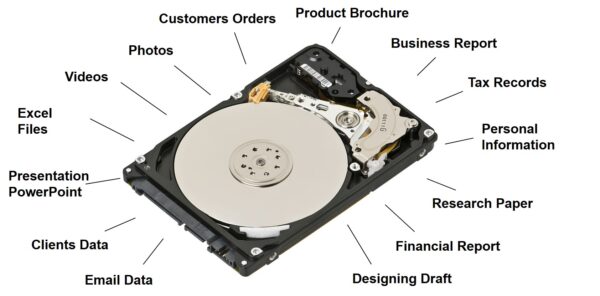Any hard drive that is not assigned any drive letter or when, its data isn’t accessed by any program, such a drive is called as unallocated drive. Simply put, any physical space that does not belong to a partition is said to be unallocated. It mainly happens, when any virus harms the file system, or when the disk drive has bad sectors. You won’t be able to see the unallocated drive in the File explorer, but would be able to track the status from Disk Management. Also, it’s not possible to access the entire data stored on the unallocated hard drive. That’s why, it becomes crucial to fix the unallocated disk drive. To help you do so, below we have mentioned some of the effective troubleshooting techniques that may help you do so.
Reasons Why Hard Disk Drive Becomes Unallocated
As mentioned, one of the major reasons due to which the hard drive become unallocated is the file system corruption. However, there are other reasons as well. We have covered all such possible causes below:
- Bad Sectors on Disk Drive
- Hardware Failure
- Outdated Driver
- Unexpected Power Failure
- Virus Attack
Troubleshooting Methods To Fix Unallocated Disk Drive
Below we have mentioned some of the effective ways that may help you recover data from an HDD unallocated disk drive:
Method 1: Update your Hard Drive Drivers
One of the common reasons behind an unallocated disk is outdated drivers. Therefore, you need to make sure that your hardware drivers are updated. If not, then proceed with the below-give steps to update your drivers:
- Click on the Windows icon and select the Disk Management option.
- Further, right-click on the unallocated volume at the bottom of the window and select the Properties option.
- Now, go to the Driver tab and select the Update Driver option.
- After that, click on “Search automatically for drivers” and let the Windows search for updated drivers and install them.
- Once done, reboot your computer.
Method 2: Enable the unallocated device using Device Manager
- Click on the Windows icon and type ‘computer management’ in the text field. Then, press the Enter key.
- From the Window that opens up, go to System Tools followed by Device Manager.
- From there, expand the “Disk drives” node.
- Right-click the USB flash drive and select “Enable device” option.
Method 3: Fix Unallocated Disk Drive using CMD
The Command Prompt (CMD) can also help you fix the unallocated disk. For doing so, you must proceed with the below-given steps:
- Simultaneously press the “Windows + R” keys and press the Enter key.
- Then, type diskpart in the Command Prompt window, and press the Enter key.
- When prompted to give permission, click on Yes.
- In the DiskPart window, type “list volume” and press the Enter key.
- After that, type “select volume <volume number>” and press the Enter key.
Note: Here, the volume number is the number of the volume that is marked as unallocated.
- Type “delete volume” in the pop-up window and again, press the Enter key.
Method 4: Convert the unallocated drive to RAW drive using Disk Management
- Go to Storage > Disk Management on the Computer Management utility.
- Right-click the unallocated USB flash drive and select “New Simple Volume” and click on Next.
- Again, click on Next to specify volume size.
- Followed by that, click on Next to assign the highlighted drive letter.
- Moving ahead, select “Do not format this volume” option and click on Next> Finish.
Doing this, will convert the unallocated drive to RAW drive and it will be visible in File Explorer without any storage size.
Method 5: Restore the recovered files to the formatted USB disk drive
You will be able to access the RAW disk drive, once you have formatted it. But the formatted drive will now be empty. Thus, you need to restore the files to the newly formatted drive by following the below-given steps:
- Go to the location wherein you have stored the recovered files.
- Then, copy all these files and paste it to the newly formatted disk drive.
This, will surely help you recover your lost data from the unallocated disk drive.
Note: The above-mentioned DIY approaches may help you resolve the unallocated disk issue. But, there are certain risks associated with them. To explain, while using the CMD method, one has to be very careful since it is a command line based tool. A minor mistake can harm your data and your computer as well.
Method 6: With Data Recovery Software
If none of the above methods work, then you can use a professional data recovery software, such as Stellar Data Recovery for Windows to recover data from an HDD unallocated disk drive. Here are the steps that will help you recover data using Stellar Windows Data Recovery Software:
- At first, you have to download, install, and launch the Stellar Data Recovery Software.
- Then, click on the Select What to Recover option followed by All Data and Next.
- Go to the “Recover From” window and choose the disk drive.
- Turn on “Deep Scan” at the bottom-left corner and click on “Scan”.
- Once recovered, preview the recoverable files and select the required files and click on “Recover”.
- Click on “Browse” to select the desired location to save the recovered files. Make sure to choose another drive. Click on “OK”.
Once you have successfully recovered your data, format the RAW drive so that you can use it again. You may do so by following the below-stated steps:
- Go to File Explorer and right-click on the RAW disk drive, then select the Format option.
- Go to the Format dialog box, click Start with default settings already selected. Doing this will format the RAW drive with the NTFS file system.
- It will help you use the drive as a new one.
Summing It Up
We hope the methods mentioned in this blog would have helped you recover data from an HDD unallocated disk drive. To begin, you have to enable the unallocated disk drive by using Disk Manager. Then, convert the unallocated drive to the RAW drive by using Disk Management. Once you can see your drive in the File Explorer, you can use a data recovery software such as Stellar Data Recovery Software to recover your lost data from the RAW drive.


















Be First to Comment